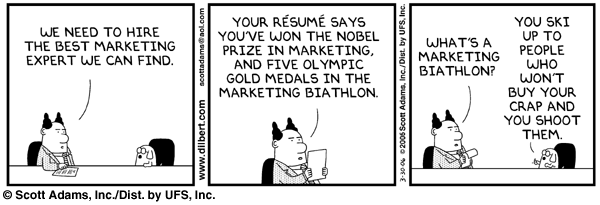Marketing for financial institutions. Part One: Campaigns

Sad but true
In order to at least somehow systematize my knowledge of digital marketing (today's phrase), I decided to write a series of articles on how I personally managed to tidy up marketing in financial institutions (aka banks).
Intro
I have been involved in Oracle Siebel projects for a long time, but now I have moved into the field of business analysis, although I have quite a lot of experience in implementing solutions based on this product (5+ years). And every time, on absolutely any marketing project, I see that it is not always on the part of the customer that there is a clear understanding of how to do marketing in the realities of the 21st century.
To begin with, under absolutely any conditions, the return on the implementation of a marketing solution is slightly more than the maximum of the possible set of directions (sales, debt collection, consolidation of the client base, credit conveyors, etc.).
This article will focus on campaigns: what types and types are there, to whom they apply. I sincerely hope for the Habra community in terms of questions and the direction of my reasoning in future articles.
Campaign Types
Single wave
Everything is extremely simple - we launch the campaign, collect the results (feedback), take our favorite
Single-wave campaigns work great when the number of campaign participants is reasonable.
A great example of a one-wave campaign is to move sleeping clients with some special offer so that they return to the
Multiwave
Multi-wave campaigns were born from the understanding that in real life not all campaign participants can be processed in one pass. Of course, the exception is campaigns that are focused on electronic delivery channels, but for, say, outgoing calls, resources are limited by the number of operators (either their own or outsource) - an excessive load on delivery channels with a human resource entails incomplete campaigns (not all phoned, for example), so it’s difficult to evaluate the results of such a campaign. For electronic channels, the wave option is also applicable if, for example, an outsource gateway is used for mailing with stepwise pricing (i.e. inhuman delivery).
Therefore, the concept of waves is used for large-scale campaigns: a large segment of campaign participants are beaten in batches that are transferred to processing channels, while planning a campaign it is assumed that a certain channel will work out another “pack” in the allotted time period (usually measured in weeks or month).
From my own experience I can say that few people do multi-wave campaigns - usually, after calculating the capacity of the channels, they make smaller segments of the campaign participants and launch single-wave campaigns.
The beauty of multi-wave campaigns is that each wave can be scheduled to start in advance and then not be fooled with a manual start.

In a multi-wave marketing biathlon, I would have to run a few laps
Campaign Types
If the type of campaign gives us an idea of how many visits this campaign will take, the type of campaign tells us what we are trying to achieve with this campaign. The following types are predominantly distinguished:
- Acquisition of new customers;
- Raising customer awareness about the products and services of the bank;
- Cross-selling;
- Increase customer loyalty;
- Stimulation through recommendations;
- Customer retention;
- Additional / increasing sales;
- Interception of other people's customers.
New customer acquisition
This type of campaign is aimed at processing the so-called "Prospectuses" - prospective clients, but still not those.
How to become a prospectus? Go to the bank and leave your contact details, while you can not get anything from the bank.Before the start of such a campaign, customers are identified from the entire client base (in fact, you cannot even name them customers) who do not have a single product / service at all. And for such "quiet people" some simple offer is drawn up, for example, a debit card with a cash back / bonus scheme and a grace period of service of six months to a year.
Raising customer awareness of bank products and services
In this case, not “prospectuses” are processed, but real clients. A feature of such clients, as a rule, is the use of a banking product for a very long amount of time without transitions / connection of additional services. For example, a client at some point put 300 thousand rubles in a deposit at 7% per annum with prolongation, and has been holding this deposit for several years, although the bank has exactly the same product in its portfolio, only at a more favorable rate and with capitalization. Accordingly, it would be nice to tell the client about this, and he, you see, and something else he will look into the burden of the deposit.
Cross selling
A classic example of campaigns that is ubiquitous. An example from a retail sales textbook: if a customer purchases a camera, sell him a coffer, a protective filter, and an additional battery. The essence of cross-selling is not to sell a similar product, but more expensive, but at the same time “hang” the client with additional things . The banks usually use the following campaign type: for credit card holders who do not have an Internet bank connected, they form an offer to connect this same Internet bank (when it is paid, otherwise why?).

Increase customer loyalty
Yes, these are the same points, bonuses, virtual rubles, miles and so on. This type of campaign is aimed at increasing customer spending in pursuit of mythical bonuses. It is found everywhere.
Incentives through recommendations
It’s also a classic example of a campaign, called referral campaign in a foreign country: bring a friend, you’ll get a nyasha. Why are people pecking at this? Because they give virtual pies for this: discounts on service, 100500 points, a free month of service in the concierge service (for some, after that it blows the roof off tightly, banks like these).Customer retention
A very subtle thing that I personally saw only 1-2 times. The bottom line is that BKI is not sleeping, and in theory the bank can know about where and in what volumes you use banking services, including competitors. And as soon as the bank understands that the number of transactions (read, money) begins to decline, this switch turns on to return you back to the bank. In this case, they get a secret weapon : personal offers. The bottom line is that for a very narrow circle of customers, similar to each other like two drops of water (from the point of view of the bank, of course), they formulate a proposal with individual conditions, sometimes contrary to all laws of
Extra / boost sales
Unlike cross-selling, they offer goods that are more expensive, but better: platinum cards instead of the usual ones, for example. By the way, very often cross-selling and boosting sales are dumped in one heap, plainly not understanding what and where.
Interception of other customers
A subtle thing that is not always talked about, especially in the presence of consultants. The bottom line is to distract the client from the use of competitor products and attract them again. How does the bank know about such things? It is very simple, when you fill out a questionnaire for a loan, you indicate without fail what other existing products / loans you have. Then everything is simple.
Who do they apply to
Or, in other words, what are client segments?

It's all about segments,% habrauser%!
In part, I already wrote about this above, but now in a little more detail.
KO will notice that the campaigns are spreading to customers, and he’ll be damn right, but how many? In my practice, I saw only two (three, but with a very big stretch) approaches:
- Segmented campaigns
- General (non-segmented) campaigns.
At the same time, segmented campaigns are divided into individual (see "Customer Retention") and portfolio. The main difference is the number of customers in the segment. For individual campaigns, 2-3 dozens per segment are recruited, for portfolio campaigns, from several hundred to several thousand.
Segmentation rules sometimes take on a completely monstrous appearance, for example: give me all male clients who are 24 to 29 years old, married, without children, without delay in loans and always with a mortgage living in Kazan.
If we talk about Collection (collection of overdue debts), then there the segments are built mainly by the value of the delay with the accuracy of the ruble.General (non-segmented) campaigns are used to carry out any actions, for example, for all customers who opened a deposit this month, the bank gives 2,000 bonuses to the account (an example of an unsegmented campaign to increase customer loyalty).
An important point: if you plan to give 2000 bonuses when opening a deposit this month only to Novosibirsk customers, then this is not a general campaign, but segmented by the only sign - the city of registration.
Outro
I hope that the material will be useful, maybe for someone new.
In the next article I’m announcing a story about the delivery channels of proposals and how the campaign is carried out depending on the channel.
